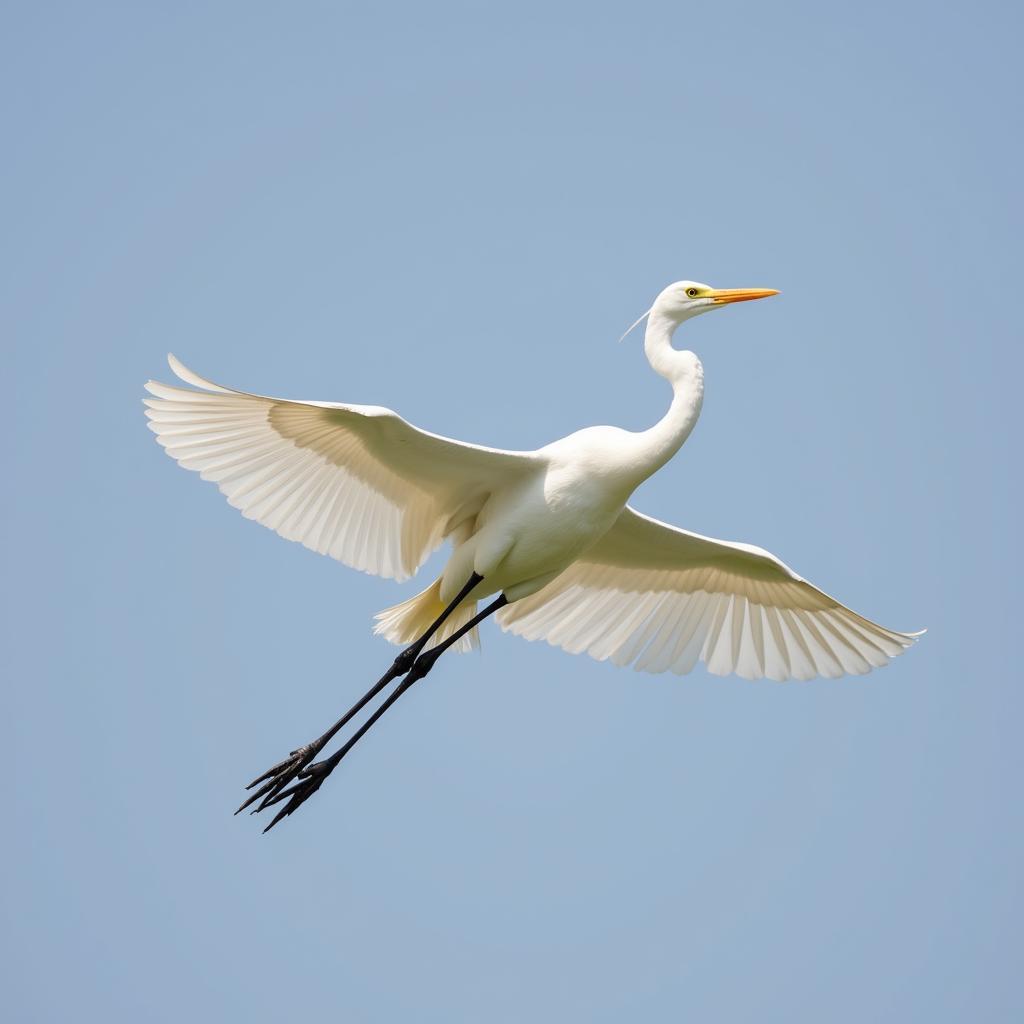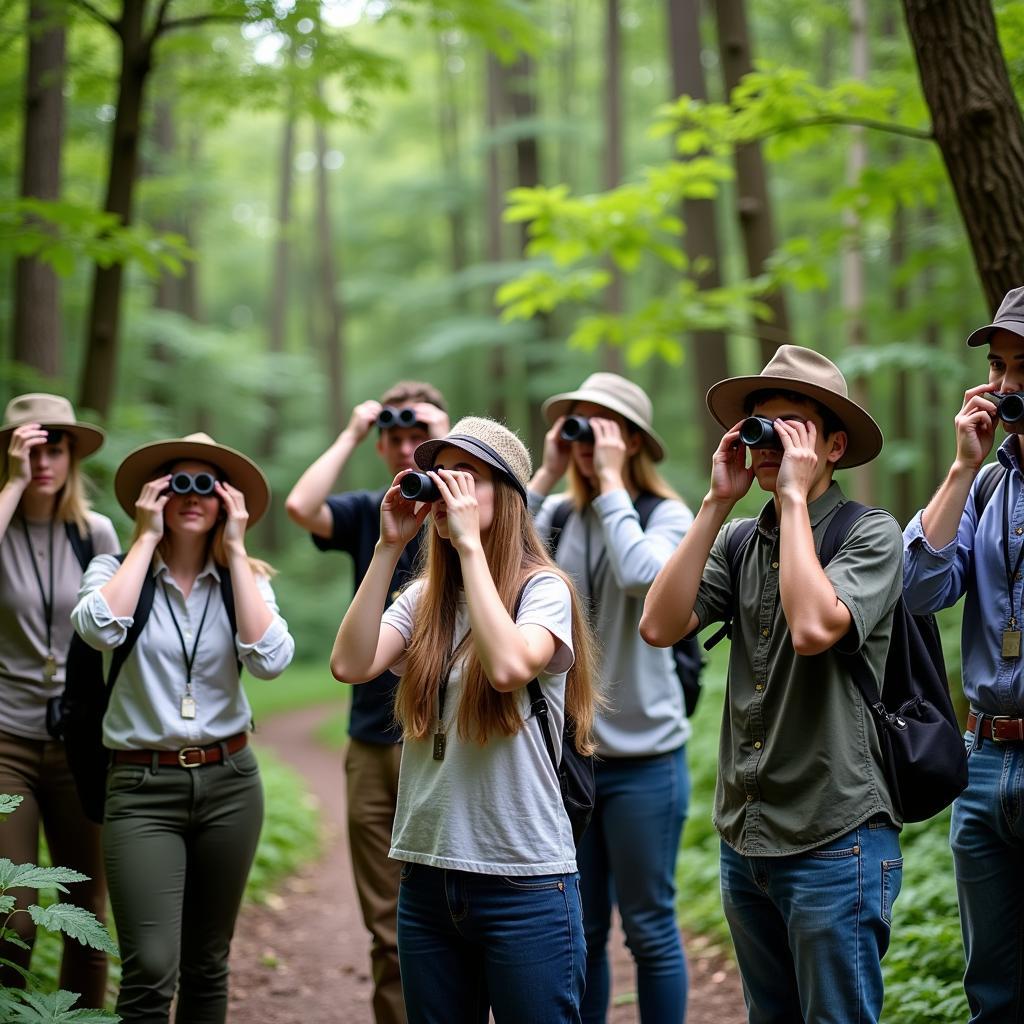The bird symbol of the Audubon Society is more than just a logo; it’s a powerful emblem of hope and a call to action for the conservation of birds and their habitats. But what bird holds this honor, and what is the story behind it?
 Great Egret soaring through the sky
Great Egret soaring through the sky
The Great Egret: From the Brink to a Symbol of Resilience
The National Audubon Society’s iconic bird symbol is the Great Egret, a large, strikingly beautiful wading bird known for its snowy-white feathers, black legs, and yellow bill. In the late 19th century, however, this species faced a grave threat from the fashion industry. Their elegant plumes, prized for adorning hats, became a hot commodity, leading to rampant hunting that pushed the Great Egret to the edge of extinction.
This period, sadly, marked a time when the beauty of birds became their downfall. The demand for plumes decimated bird populations across the globe, turning what we now consider symbols of freedom and grace into victims of human vanity.
The Audubon Society Takes Flight
Amid this ecological crisis, a beacon of hope emerged. In 1886, George Bird Grinnell, a passionate conservationist, founded the Audubon Society, named in honor of the renowned ornithologist John James Audubon. The organization’s primary mission was to combat the senseless slaughter of birds for fashion and protect their rapidly disappearing habitats.
The choice of the Great Egret as the Audubon Society’s symbol was no accident. Having witnessed the devastating impact of the plume trade firsthand, Grinnell recognized the urgent need to protect this magnificent species. By adopting the Great Egret as its emblem, the Audubon Society sent a powerful message: these birds were not commodities to be exploited but rather treasures deserving of our respect and protection.
 Audubon Society members observing birds in their natural habitat
Audubon Society members observing birds in their natural habitat
A Legacy of Conservation
Over a century later, the Great Egret stands as a testament to the success of the Audubon Society’s conservation efforts. Thanks to the organization’s tireless advocacy, public awareness campaigns, and the establishment of protected areas, the Great Egret population has rebounded. Today, these elegant birds grace our wetlands and shorelines, their presence a reminder of the power of collective action and the importance of safeguarding our planet’s biodiversity.
symbol of national audubon society
The Bird Symbol: A Call to Action
The Great Egret, as the bird symbol of the Audubon Society, embodies the organization’s unwavering commitment to conservation. It serves as a poignant reminder of the interconnectedness of all living things and the responsibility we all share to protect the natural world for generations to come.
“The Great Egret’s story is a powerful reminder that we can reverse course even when faced with seemingly insurmountable environmental challenges,” says Dr. Emily Carter, a leading ornithologist and conservation advocate. “Through collective action and unwavering dedication, we can make a tangible difference in safeguarding our planet’s biodiversity.”
Continuing the Legacy: How You Can Help
The fight for conservation is far from over. Birds continue to face numerous threats, including habitat loss, climate change, and pollution. Here’s how you can make a difference:
- Support the Audubon Society: Join your local chapter, volunteer your time, or donate to support their crucial work.
- Create Bird-Friendly Habitats: Plant native trees and shrubs, provide water sources, and avoid using pesticides in your yard.
- Reduce Your Carbon Footprint: Embrace sustainable practices to mitigate the impacts of climate change on birds and their habitats.
- Educate Others: Share your passion for birds and conservation with your family, friends, and community.
By embracing the Audubon Society’s mission and drawing inspiration from the Great Egret’s resilience, we can collectively create a brighter future for birds and all life on Earth.
Frequently Asked Questions
What does the Audubon Society do?
The Audubon Society is dedicated to protecting birds and their habitats through science, advocacy, education, and on-the-ground conservation efforts.
Why are birds important?
Birds are crucial indicators of environmental health. They play vital roles in ecosystems as pollinators, seed dispersers, and pest controllers.
How can I help birds in my area?
You can make a difference by creating bird-friendly habitats in your backyard, supporting local conservation organizations, and reducing your environmental impact.
What are the biggest threats to birds today?
Habitat loss, climate change, pollution, and invasive species pose significant threats to bird populations worldwide.
Where can I learn more about birds and conservation?
The Audubon Society’s website, as well as reputable ornithological organizations, offer a wealth of information on bird identification, conservation efforts, and how to get involved.
Need support? Contact Hotline: 02043854663, Email: [email protected] Or visit us at: Zone 34, Bac Giang, 260000, Vietnam. Our customer service team is available 24/7.
Explore more: For more information on the Audubon Society and their work, check out bird symbol national audubon society. You can also find resources on how to get involved in conservation efforts and make a difference for birds in your community.